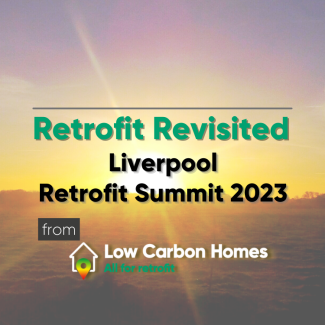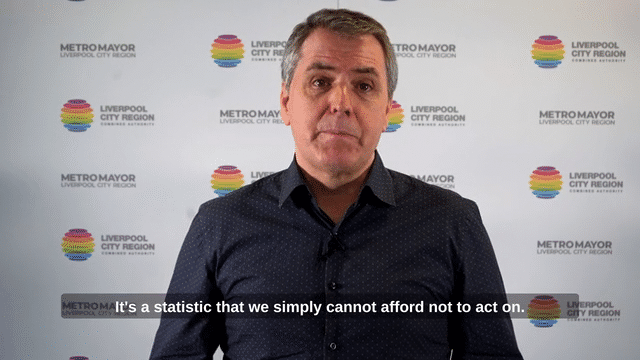Liverpool Retrofit Summit - revisited!

For Liverpool City Region Metro Mayor Steve Rotherham, retrofit is deeply personal. “Having grown up in a council house in the 1960s,” Steve said during our latest Retrofit Revisited Summit.

“I know the safety net that a good quality home can provide for families when times are tough,” Steve said. “That journey towards a fairer, more equal future for the 1.6 million people here starts at home.”
Liverpool City Region was forging ahead on retrofit, setting the city region the ambitious target to be net zero carbon by 2040 and vowing to eradicate fuel poverty. “We will be investing £60 million in robust retrofitting programmes,” the mayor announced, “targeting thousands of the most vulnerable homes and helping them save hundreds of pounds on energy bills.”
Many of the other senior Liverpool City Region Combined Authority (LCRCA) stakeholders who spoke at our summit clarified how the combined authority would be translating these ambitions into practice.
“We’ve been working with our central government colleagues to attract a lot of significant retrofit funding to the city region,” announced Tracy Gordon, the LCRCA’s Lead Officer for Housing Partnerships, before identifying which programmes were running and how much funding the LCRCA had gained exactly.
Tracy also gave us a sneak preview of the combined authority’s Five Year Net Zero Carbon Action Plan, which comes out later this year.
👆🏻 ▶ Log in/sign up to Low Carbon Homes online to watch all of the Liverpool 2023 videos ▶ and more - all free
Supporting people in times of crisis
With millions struggling with spiralling energy bills this winter, we were delighted to have Energy Projects Plus Business Relationship Manager Dominic Griffiths give a timely and important presentation about the challenges of providing energy advice and support in times of crisis. “The amount of people who need to get themselves out of crisis is far more than we’ve experienced before,” he reported.
Dominic then explained how EPP was coping with this unprecedented demand for energy support services. “We are determined to never close our energy advice line or referrals from our partners,” he said. “But that means we have had to change the way we work and implement a triage process around our three priority groups.”
Dominic then outlined who those groups were – vulnerable clients without access to heat, prepay customers at risk of self-disconnection and vulnerable clients living in homes with damp and mould – and what tailored support EPP could offer them like replacing their heating system, providing winter warm packs and helping them apply for benefits.
Some of our brand partners also shared how they were helping households struggling with spiralling energy bills through whole house retrofit. Russell Banton, ECO Business Development at E.ON, told us how his company was helping through the ECO4 grant.
“We’re obliged to spend £200 million per year between 2022 and 2026,” he announced, before running through the eligibility criteria for privately owned or rented properties and social housing, and what criteria E.ON uses to effectively target ECO4 support.
Empowering the able-to-pay
While it was great to learn how the local retrofit community was helping vulnerable households, another big focus for our summit was how best to support the 14.1 million homes in the able-to-pay market to cut emissions and energy bills.
“The ECO4 and ECO+ grants won’t deliver all of the things we need,” said LCRCA Housing Retrofit Manager David Colbourne in his closing remarks. “We do need to look at providing different and wider partnerships, particularly for the able-to-pay market.”
Becky Lane, Co-founder and CEO of Furbnow, provided some clarity on why it is exactly that able-to-pay households are stuck, based on invaluable feedback from their customers.
“It’s very difficult as a homeowner to run a retrofit project alongside your day job,” she said. “Many people find it hard to decide on what measures to pick and finding those tradespeople who deliver to specification and deliver high quality output can be difficult.
“It can be quite disempowering. People shouldn't need a degree in building physics to figure out how to retrofit their home and we at Furbnow believe there should be innovation in the customer service required to make this information as accessible as possible.”
Becky then outlined the excellent range of project management services Furbnow offers homeowners through their retrofit journey. “We’ve built a platform which means homeowners receive a consistently high level of service that helps them move forward.”
Other promising solutions for the able-to-pay market included Solar Together, a scheme to help able-to-pay households find trusted installers. Tracy Gordon explained to us how they recruited households for the scheme, how many installations are now going ahead and how many companies the combined authority is partnering with.
Creating new contracting routes
Our panellists agreed that the fragmentation of the local retrofit supply chain was hamstringing retrofit’s rollout in the city region. “This is partly due to subcontracting, leading to a failure to invest for the long-term in skills and technology,” explained Paul Amann, Employment and Skills Policy Team at the LCRCA, as he painted the local retrofit skills picture.
“60,000 jobs will require upskilling and 63,000 jobs will be in higher demand across the city region,” he said. “Crucial will be the attractiveness of a wider talent pool of people. Too many young people, women and people from our BAME communities are not attracted to the sector.

James Johnson, Programme Manager, North West Net Zero Hub, highlighted some of the lessons his organisation had learned about maturing the supply chain from rolling out phase two of the Local Authority Delivery programme.
“The sheer volume of contracts that were suddenly placed in the market created difficulties,” he reflected. “The large national providers that bid for and won multiple contracts found themselves overstretched, with difficulties retaining some contractors.”
James explained how working with Procure Plus largely helped overcome this. “They established a retrofit programme delivery service, DPS, which registered not just large turnkey providers, but also smaller firms.” Small firms still arguably face a barrier into local government contracts, James admitted before adding that LAD 2 had “created new contracting routes.”
LAD 2 was also the first to use the quality standard PAS 2035, with some success.
“We believe there is more work to be done on maturing the supply chain’s use of the quality standard and some improvements could be made to the standard itself.”
James also showed us the LAD 2 measures they had taken by property types and how much money the LAD offered per property on average, and overview of the final funding amounts per LEP Area in the north west, and tips on messaging towards householders.
Heat networks/Products
Local Energy Lead at the LCRCA Luca Biagioni gave attendees a clear signal on behalf of the combined authority that heat networks would play a key role in aiding the region’s journey to net zero.
“We believe heat networks will contribute 20% to the decarbonisation of the city region,” he concluded. He then showed us some local operational and funded examples, before highlighting some future collaboration opportunities.

On this theme of innovative heating systems, several of our brand partners showcased some exciting new products. Stelrad Area Sales Manager Dominic Hills ran us through his company’s unique range of low-temperature heating systems and estimated savings per housing archetype. Jigsaw Infrared Managing Director Matt Billington explained how his company’s infrared heaters enabled room-by-room temperature control, were cheap to install and had lower running costs compared to other low-carbon heating systems.
Meanwhile, other brand partners showcased new building products which could revolutionise retrofit. “Our products breathe with the people in the building,” said Tom Robinson, Founder and Managing Director of Adaptavate. “The porous structure in the material enables it to absorb the 14 litres of moisture the average family creates everyday.” IndiNature Co-Founder Scott Simpson explained the benefits of his company’s flax and hemp products. “We’re local, we’re cost-competitive and we have a circular product that can be reprocessed at end-of-life.”
👆🏻 ▶ Log in/sign up to Low Carbon Homes online to watch all of the Liverpool 2023 videos ▶ and more - all free
Reported for Low Carbon Homes by environmental journalist and reporter Alex King